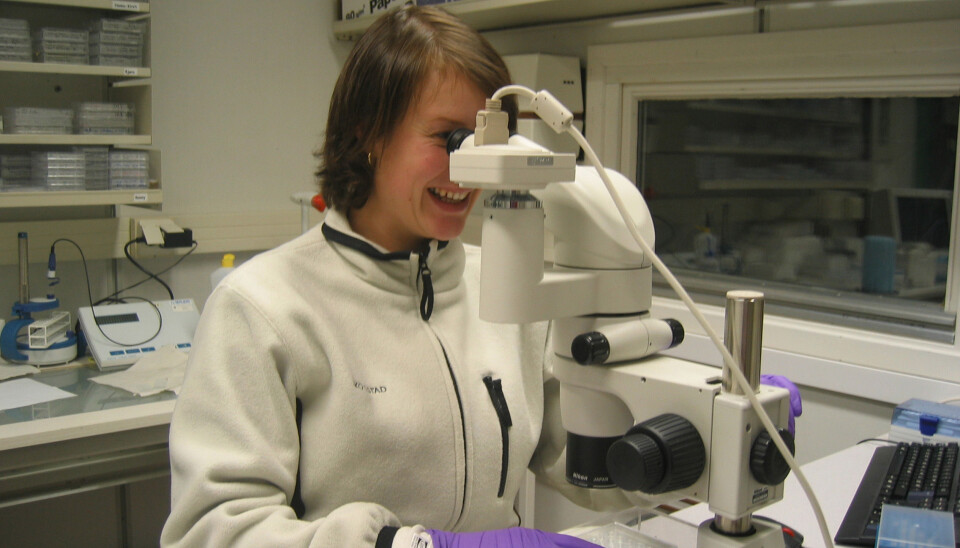An article from University of Tromsø – The Arctic University of Norway

The body's beautiful jewels
They look like beautiful precious stones. In a crystallised form, proteins can provide invaluable contributions to cancer research and vaccine development.
Denne artikkelen er over ti år gammel og kan inneholde utdatert informasjon.
Scientists at the National Centre for Structural Biology (NorStruct) in Norway are working to produce crystals. Not of precious stones, but of biological substances.
The crystals are an excellent means of achieving an important goal: expanding our understanding of how the body's key processes work.
The researchers are especially eager to uncover the secrets that are contained in proteins.
Life's building blocks
But what exactly is a protein?

Many may know the word "protein" best from the list of ingredients that make up different foods. Fish, meat, milk, cheese and eggs contain a great deal of protein.
But protein is not just food, the word is also a common term for thousands of different molecules found in living organisms. They are the cell's construction workers.
While our genetic material (DNA) contains the recipes that tell cells what to do, proteins actually undertake the processes. Many proteins are tailored to perform vital functions.
Haemoglobin, which transports oxygen around the body, is an example of such a protein.
To understand why cancer happens, you have to look at cells, which is why scientists want to know as much as possible about cellular components and functions. Since proteins do their job inside cells, they are naturally considered to be quite important.
The technique that scientists use to discover the secrets inside proteins is called X-ray crystallography.
Looking for a needle in the haystack
Because there are so many different proteins in a cell, you have to "break down" the cell and "fish out" the one protein you are looking for. This process is called protein purification.
"As a rule, we can produce the proteins we are looking for in bacteria, insect cells or yeast. We produce these cells in large tanks. Using human cells is in most cases too time consuming and costly," says Vibeke Os, of NorStruct.
After purification, the proteins are divided into tiny test tubes, to which are added various salts, metals or solvents.
The fluid is steamed away, something which makes the proteins "feel uncomfortable" and causes them to agglomerate in a specific pattern. The result is a pattern that looks like a crystal.
All this work is very time consuming, and there is no guarantee that the scientists will be able to get crystals out of the process. Often, they don't.
Os says it's like looking for needle in a haystack, so it's great when they succeed.
"It feels fantastic to create a perfect, diamond-shaped crystal," says Os.
Bombarded by radiation
Although there is a lot of work involved in creating crystals, the scientists are literally left with just tiny amounts of material to work with. A crystal of one millimetre is considered to be large, and usually they are much smaller.
To understand the information locked inside the crystals, scientists bombard the crystals with X-rays. The way in which the X-rays are bent inside the crystal says something about the atom's position inside it.
Atoms are the smallest building blocks in biological substances. And it is precisely this structure that the researchers want to understand.
"We need to know how these large biological molecules are built, atom by atom, to see how they behave under certain conditions," says Os.
Once the scientists understand this, they can add or remove portions of the molecule in order to achieve effects that originally were not possible.
This is how they can make improvements in the protein, so that it will do what they want.
Curing disease and improving cheese
The structure of a molecule, such as a protein, says a lot about how that molecule works. This kind of knowledge is crucial in both medicine and vaccine development.
Knowing what a disease-causing molecule looks like could enable us to "turn off" its activity, or increase other activities.
This could perhaps cure the disease, or prevent a disease from occurring, possibly allowing us to make medicines that we see a need for, such as birth control pills for men.
In other words, X-ray crystallography is a powerful tool that has great significance in scientific research.
"But not only just in medicine," says Os. "This knowledge can be used to create agents with enhanced cleaning properties, identify pollutants and break down waste products, develop biofuels, or for food production − like aiding in the maturation of cheese or beer".







































